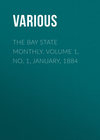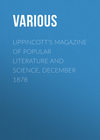Kitabı oku: «Notes and Queries, Number 179, April 2, 1853.», sayfa 2
Minor Notes
White Roses.—In an old newspaper, The Weekly Journal, or British Gazetteer, of Saturday, June 15, 1723, I find the following paragraph:
"Monday being the anniversary of the White Roses, some persons who had a mind to boast that they had bid defiance to the government, put them on early in the morning; but the mob not liking such doings, gathered about them, and demolished the wearers; which so terrified the crew, that not one of them afterwards would touch a white rose."
Can you, or any of your correspondents, explain this curious allusion? Is it to the emblem of the House of York, or the badge of the Pretender?
E. G. B.
Fifeshire Pronunciation.—I have observed, in various parts of Fifeshire, a singular peculiarity in the pronunciation of certain words, of which the following are specimens:

This strange mode is not altogether confined to the most illiterate portion of the people. My query is, Does this peculiarity obtain in any other portion of Scotland?
A. R. X.
Paisley.
Original Letter.—The following letter, written by the French general at Guadaloupe, when it was taken in 1810, to his conqueror, is an exquisite specimen of something more than that national politeness which does not desert a Frenchman even in misfortune. I possess the original:
Au quartier général du Parc,le 6 Février, 1810.
A son Excellence
Le Général Beckwith, Commandant en chef les forces de sa Majesté Britannique aux isles du Vent.
Monsieur le Général,
J'ai été prévenu que Votre Excellence se proposait de venir au Parc demain dans la matinée. J'ose espérer qu'elle voudra bien me faire l'honneur d'accepter le diner que lui offre un Général malheureux et vaincu, mais qu'il présente de tout cœur.
Daignez, Monsieur le Général, agréer l'assurance de la haute considération avec laquelle
J'ai l'honneur d'être,de votre Excellence,Le très-obéissant serviteur,Emouf.Edward Foss.
Erroneous Forms of Speech.—Since you allow your correspondents to correct such words as teetotal, I hope you will allow me to call the attention of your agricultural readers to the corruption in the word mangold, as they now write it. The word is in German mangel wurzel, root of scarcity. It is wrong to use even such a name as this, in my opinion, while we have the English name beet, which has the additional advantage of being derived from the botanical name Beta. But if a new name must be used, let it, at any rate, be the pure German mangel, and not the mongrel mangold. Indeed, those who spell the word in the latter way, ought in common consistency to write reddishes, sparrowgrass, and cowcumbers for radishes, asparagus, and cucumbers.
E. G. R.
QUERIES
EUSTACHE DE SAINT PIERRE
(Vol. vii., p. 10.)
Mr. King's inquiry reminds me of two Queries on the same subject which I sent you as far back as the end of 1851, or beginning of 1852. Those Queries have not appeared in "N. & Q.," and I was led to suppose, either that you had laid them aside for some future occasion, or had found something objectionable in the form in which they were presented. The following is a literal copy.
"There are two circumstances connected with this event (the surrender of Calais), respecting which I am desirous of obtaining information. The first has reference to the individuals who offered themselves as victims to appease the exasperation of Edward III., after the obstinate siege of that town in 1347. They are represented as six of the principal citizens; Eustache de Saint Pierre was at their head, and the names of three others have come down to us, as Jean d'Aire, Jacques de Wissant, and Pierre de Wissant. Who were the other two?
"The second point relates to the character of that occurrence. Some historians are of opinion that the devotedness of Saint Pierre and his associates was prompted by the most exalted sentiments of patriotism; while others assert that it was all a 'sham,' that Saint-Pierre was secretly attached to the cause of the English monarch, and that he was subsequently employed by him in some confidential negociations. To which of these opinions should the historical inquirer give his assent?"
I may add, in reply to Mr. King, that "the light thrown on the subject, through M. de Bréquigny's labours," has been noticed in the Biographie Universelle, sub voce Saint-Pierre (Eustache de); and it was the remarks in that work that first drew my attention to it. The circumstances disclosed by Bréquigny are also commented upon by Lévesque in his La France sous les Valois.
Henry H. Breen.
St. Lucia.
PASSAGE IN COLERIDGE
De Quincy, in his "Suspiria de Profundis," Blackwood's Magazine, June, 1845, p. 748., speaking of the spectre of the Brocken, and of the conditions under which that striking phenomenon is manifested, observes that
"Coleridge ascended the Brocken on the Whitsunday of 1799 with a party of English students from Goettingen, but failed to see the phantom; afterwards in England (and under the same three conditions) he saw a much rarer phenomenon, which he described in the following eight lines. I give them from a corrected copy. The apostrophe in the beginning must be understood as addressed to an ideal conception:
"'And art thou nothing? Such thou art as when
The woodman winding westward up the glen
At wintry dawn, when o'er the sheep-track's maze
The viewless snow-mist weaves a glist'ning haze,
Sees full before him, gliding without tread,
An image with a glory round its head:
This shade he worships for its golden hues,
And makes (not knowing) that which he pursues.'"
These lines are from "Constancy to an ideal Object;" but in the usual editions of Coleridge's Poems, the last two lines are printed thus:
"The enamour'd rustic worships its fair hues,
Nor knows he makes the shadow he pursues."
Coleridge's Poetical Works, vol. ii. p. 91., 1840.
Query: Which reading is the correct one? Coleridge refers to the Manchester Philosophical Transactions for a description of this phenomenon; but, as the earlier volumes of these are scarce, perhaps some of your correspondents would copy the description from the volume which contains it, or furnish one from some authentic source.
J. M. B.
Minor Queries
Cann Family.—Can any of your correspondents enlighten me as to the origin of this family name; and if of foreign extraction, as I suspect, in what county of England they first settled? There is a village in Dorsetshire called Cann St. Rumbold. Possibly this may afford some clue. Burke informs us that William Cann, Esq., was Mayor of Bristol in 1648, and that his son, Sir Robert Cann, also Mayor, and afterwards M.P. for that city, was knighted by Charles II. in 1662, and created a Baronet, September 13th in the same year. The title became extinct in 1765, by the death of Sir Robert Cann, the sixth Baronet. The first Baronet had several brothers, some of whom most probably left issue, as I find a respectable family of that name now, and for many years past, located in Devonshire; but I am not aware if they are descended from the same stock.
Domini-Cann.
Canada.
Landholders in Lonsdale South of the Sands.—In his History of Lancashire, Baines states (vol. i. chap. iv.) that a return of the principal landholders in Lonsdale South of the Sands, in the time of James I., has been kept; but he does not state where the return is registered, nor whether it was in a private or public form. In fact, it is impossible to make any reference to the return, from the brief mention made of it by Baines.
Perhaps some one of your Lancashire correspondents may be acquainted with the sources of the learned historian's information. If so, it would much oblige your correspondent to be directed to them, as also to any of the Lancashire genealogical authorities referring to the district of Lonsdale South of the Sands.
Observer.
Rotation of the Earth.—Has the experiment which about two years ago was much talked of, for demonstrating the rotation of the earth by means of a pendulum, been satisfactorily carried out and proved? And if so, where is the best place for finding an account of it? The diagram by Mr. Little in the Illustrated London News does not seem to explain the matter very fully.
[?]
Nelson and Wellington.—The following statement has been going the round of the American newspapers since the death of the Duke of Wellington. Is it true?—"Lord Nelson was the eighteenth in descent from King Edward I., and the Duke of Wellington was descended from the same monarch."
Uneda.
Are White Cats deaf?—White cats are reputed to be "hard of hearing." I have known many instances, and in all stupidity seemed to accompany the deafness. Can any instances be given of white cats possessing the function of hearing in anything like perfection?
Shirley Hibberd.
Arms in Dugdale's "Warwickshire," &c.—In Dugdale's Warwickshire (1656), p. 733. fig. 21., is a coat of arms from the Prior's Lodgings at Maxstoke, viz. Or, fretty of ten pieces sa. with a canton gu. And in Shaw's Hist. of Staffordshire, vol. i. p. *210., is the notice of a similar coat from Armitage Church, near Rugeley, extracted out of Church Notes, by Wyrley the herald, taken about 1597: viz. "Rugeley as before, impaling O. fretty of … S. with a canton G. Query if …"
Dugdale gives another coat, p. 111. fig. 12., from the windows of Trinity Church, Coventry; viz. Arg. on a chev. sa. three stars of the first. There is a mitre over this coat.
Can any of the correspondents of "N. & Q." assign the family names to these arms? Does the mitre necessarily imply a bishop or mitred abbot; and, if not, does it belong to John de Ruggeley, who was Abbot of Merevale (not far from Coventry) temp. Hen. VI., one branch of whose family bore—Arg. on a chev. sa. three mullets of the first. I may observe that this John was perhaps otherwise connected with Coventry; for Edith, widow of Nicholas de Ruggeley, his brother, left a legacy, says Dugd., p. 129., to an anchorite mured up at Stivichall Church, a member of St. Michael's Church, Coventry.
The same coat (i. e. with the mullets) is assigned by Dugd., p. 661. fig. 12., to the name of Knell.
J. W. S. R.
Tombstone in Churchyard.—Does any one know of a legible inscription older than 1601?
A. C.
Argot and Slang.—I shall be much obliged by learning from any correspondent the etymons of argot (French) and slang, as applied to language; and when did the latter term first come into use?
Thos. Lawrence.
Ashby-de-la-Zouch.
Priests' Surplices.—Will some of the readers of "N. & Q." favour me with a decision or authority on the following point? Does a priest's surplice differ from that worn by a lay vicar, or vicar choral? I have been an old choir-boy; and some few years since, as a boy, used to remark that the priests' surplices worn at St. Paul's, the Chapel Royal, and Westminster Abbey, were, as a sempstress would term it, gaged, or stitched down in rows over the shoulders some seven or eight times at the distance of about half an inch from each other. In the cathedral churches of Durham, York, Hereford, Worcester, Gloucester, and Oxford, I have remarked their almost universal adoption; but, to the best of my belief, I have never seen such a description of vestment in use among parochial clergymen, above half-a-dozen times, and I am desirous of knowing if the gaged surplice is peculiar to cathedrals and collegiate churches (I have even seen canons residentiary in them, habited in the lay vicar's surplice), or is the surplice used by choristers, undergraduates, and vicars choral, which, according to my early experience, is one without needlework, the correct officiating garment; the latter is almost universally used at funerals, where the officiating priest seldom wears either his scarf or hood, and presents anything but a dignified appearance when he crowns this négligée with one of our grotesque chimney-pot hats, to the exclusion of the more appropriate college cap.
Amanuensis.
John, Brother German to David II.—Can any of your readers solve the problem in Scotch history, who was John, brother german to King David II., son of Robert Bruce? David II., in a charter to the Priory of Rostinoth, uses these words: "Pro salute animæ nostræ, etc., ac ob benevolentiam et affectionem specialem quam erga dictum prioratum devote gerimus eo quod ossa celebris memoriæ Johannis fratris nostri germani ibidem (the Priory) humata quiescunt dedimus, etc., viginti marcas sterlingorum, etc." Dated at Scone, "in pleno parliamento nostro tento ibidem decimo die Junii anno regni sexto decimo."
The expression "celebris memoriæ" might almost be held to indicate that John had lived to manhood, but is perhaps only a style of royalty; nevertheless, the passage altogether seems to lead to the inference, that the person had at least survived the age of infancy. King Robert's bastard son, Sir Robert Bruce, had a grant of the lands of Finhaven, in the neighbourhood of Rostinoth.6
De Camera.
Scott, Nelson's Secretary.—Can any of your readers give me information as to the pedigree and family of John Scott, Esq., public secretary to Lord Nelson? He was killed at Trafalgar on board the Victory; and dying while his sons were yet very young, his descendants possess little knowledge on the subject to which I have alluded. He was, I think, born at Fochabers, near Gordon Castle, where his mother is known to have died.
A Subscriber.
The Axe which beheaded Anne Boleyn.—A friend of mine has excited my curiosity by stating, that in his school-boy readings of the history of England, he learned that the axe which deprived Henry VIII.'s second wife (Anne Boleyn) of her head was preserved as a relic in the Northgate Street of Kent's ancient citie, Canterbury. I have written to friends living in that locality for a confirmation of such a strange fact; but they plead ignorance. Can any of your numerous readers throw any light relative to this subject upon the benighted mind of
Philip West.
Roger Outlawe.—A friend of mine in Germany has met with some ancient rolls, said to have been from the Irish Court of Common Pleas, chiefly of the time of Edward III., and headed thus:
"Communia placita apud Dublin coram fratre Rogero Outlawe priore hospitii sancti Johannis de Jerusalem in hibernia tenens locum Johannis Darcy le Cosyn Justiciarii hiberniæ apud Dublin die pasche in viiij mense anno B. Etii post ultimum conquestum hiberniæ quarto."
Can any person state who this Roger Outlawe was? And is it not singular that a prior of a religious and military establishment should be qualified to sit as locum tenens of a judge in a law court?
H. T. Ellacombe.
Clyst St. George.
"Berte au Grand Pied."—I should be glad to know what is the history or legend of the goose-footed queen, whose figure Mr. Laing, in his Norway, p. 70. 8vo. edition, says is on the portals of four French cathedrals.
Thos. Lawrence.
Ashby-de-la-Zouch.
Lying by the Walls.—What is the origin of the phrase "Lying by the walls," an euphemism for dead? It was very commonly used in this county some years ago. Instead of saying "Poor M. or N. is dead," they always said "Poor M. or N. lies by the walls."
R. P.
St. Ives, Hunts.
Constables of France (Vol. vi., pp. 128. 254.).—Has no person been appointed to fill that high office since the death of the Duc de Luynes, in 1621?
A. S. A.
Wuzzeerabad.
St. John's Church, Shoreditch.—The church of St. John, within the priory of Holywell, Shoreditch, and the chapel adjoining it, built by Sir Thomas Lovel, treasurer of the household to King Henry VII., knight of the most noble Order of the Garter, &c.
Is there any better or other account of this priory, church, and chapel than that given in the Monasticon? Judging by the statement copied by Mr. Lysons from the original entry in the books of the College of Arms, the chapel must have been a splendid building. Sir Thomas Lovel was buried there on the 8th June, 1525, "in a tombe of whyte marbell which both hit and the chappell were founded by hym, and it stondeth on the southe syde of the quyre of the saide churche." At his funeral there were present the Bishop of London, Lord St. John, Sir Richard Wyngfield, and many others, nobles and gentlemen. The Abbot of Waltham, the Prior of St. Mary Spital, four orders of friars, the Mayor and all the aldermen of London, the gentlemen of the Inns of Court, the Lord Steward, and all the clerks of London, &c., also attended. What a contrast to the present condition of the place, now a scavenger's yard, once the apparently last resting-place of the councillor of a mighty sovereign! "They that did feed delicately, that were brought up in scarlet, embrace dunghills. The holy house where our fathers worshipped is laid waste."
Warden S. Hendry.
P. S.—Part of the chapel is now to be found under the floor of the "Old King John," Holywell Lane. The stone doorway into the porter's lodge of the priory still exists; but, from the accumulation of earth, the crown of the arch is six feet below the ground. I took a sketch of it, and some other remains of the priory, also under ground, about ten years ago.
W. S. H.










